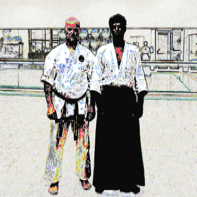
MATSUBAYASHI SHORIN-RYU / OKINAWAN KOBUDO
Master Sensei Eihachi Ota, Hanshi (pictured) , Founder and Chief Instructor of the Okinawa Shorin-ryu Karate-do & Kobudo Association (S.K.K.A.) has bestowed on us the trust to teach Matsubayashi Shorin-ryu, a traditional Okinawa style of karate-do, as it was taught to him from the founder of the style, O’Sensei Shoshin Nagamine, among other legends of Okinawan karate-do.
The deep understanding and application of body mechanics, further developed by Shihan Ota during his lifelong experiences as a martial artist, enhances the benefits derived from the execution of karate-do techniques.
Sensei Juan Queris is the ranking sensei and Head Instructor of our S.K.K.A.-associated schools in the state of Florida. He emphasizes this philosophy and is a believer in hard training to ensure proper conditioning of the body, mind and spirit. Strong training, perseverance and discipline are central to developing a practitioner’s expertise in the martial arts, as in any other worthy endeavor.
Our school is founded on this philosophy, as emphasized by Master Sensei Ota’s mission statement: “… to introduce unique training exercises to help practitioners develop their skills and increase their knowledge of the art.” This empowers all of us to focus in karate as we would in our efforts in any enterprise we wish to pursue in our personal lives.
One of the most important goals in our school is to improve the character and intrinsic quality of life, health and spiritual well being of the practitioners of this ancient martial art. Among the many exercises we practice, Sensei Juan emphasizes kata, also known as forms, as a central discipline to develop skill, understanding and the ability to successfully and effectively perform the techniques within this traditional style of Okinawan Shorin-ryu Karate-do.
OKINAWAN KOBUDO
The art of kobudo was developed as a means of survival. The development of Okinawan Kobudo came alongside open hand techniques, as occupying forces decreed possession of weapons illegal and made the local civil population relinquish traditional weapons, such as swords, lances, spears, bow and arrow and such.
Okinawan kobudō (古武道; also known as Ryūkyū Kobujutsu, Koryū, or just as Kobudō) is a Japanese term that can be translated as "old martial way of Okinawa". It generally refers to the classical weapon traditions of Okinawan martial arts, most notably the rokushakubo (six foot staff, known as the "bō"), sai (dagger-shaped truncheon), tonfa (handled club), kama (sickle), and nunchaku (chained sticks), but also the tekko (knuckledusters), tinbe-rochin (shield and spear), and surujin (weighted chain). Less common Okinawan weapons include the tambo (short stick), the hanbō (middle length staff) and the eku (boat oar of traditional Okinawan design).
The civilian Okinawan population developed the discipline to manipulate common and adaptable every day tools into very effective combat weapons.
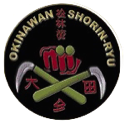
PROFICIENCY
As students train they develop their natural skills and abilities, as well as discover new ones. As students master these abilities they go from being beginners to intermediates and finally to advanced students. What follows are brief descriptions of students at each of these general levels.
1. Beginner: During the first months students will be taught basic kicks, blocks, punches, forms (katas), one step sparring and drills. They will start as a white belt level at this level and will be give the opportunity to test for the next belt level after three months have been completed. Students who do not demonstrate proficiency in these basic skills will not pass the examination and will continue training in the basic skills for another three months, when they can test again.
2. Intermediate: Our intermediate level students wear yellow, orange, blue, green and purple belts. They learn all basic karate forms (katas), drills, focus training and sparring techniques to reach a very profound level of execution, as well as self defense and self control while increasing their awareness of karate training. Duration at this level will depend on the student’s ability to learn, to adapt, and to execute all techniques to a higher level.
3. Advanced: Brown and black belts. Students at these levels will have mastered all basic forms (katas), drills, focus training, free style sparring, multiple attach self defense, Kata bunkai (i.e. application of techniques), basic techniques to a higher level of proficiency. They have begun their path to a higher (philosophical) level of karateka. Advancement at these levels will be at the instructor’s discretion and authorization.
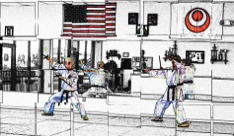
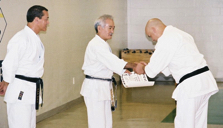


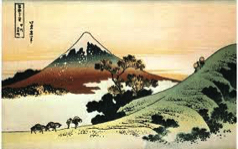
SKKA Chief Instructor
Los Angeles, California
SKKAF Head Instructor
Juan Queris, Rokudan
Winter Haven, Florida
SKKAF Instructor
Doral, Florida
Personal haiku:
“Ageless, shapeless, alert
I, my opponent unaware,
conquer in equanimity”
Shorin-ryu Karate-do and Kobudo Association of Florida
